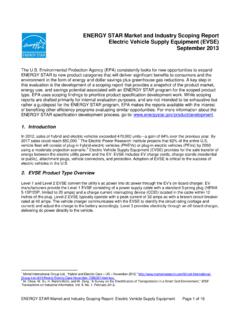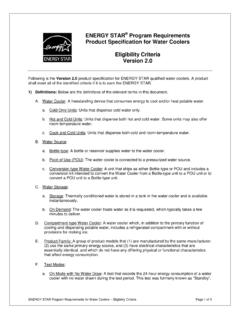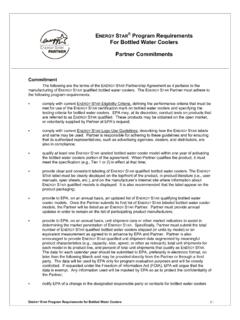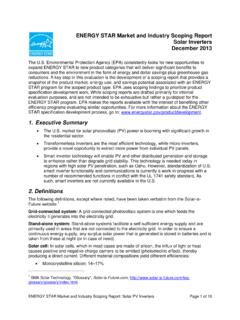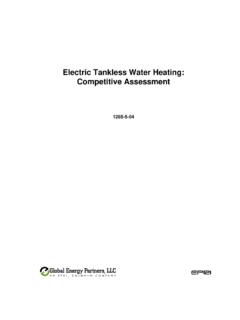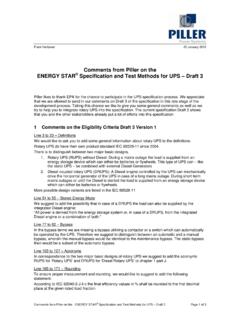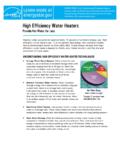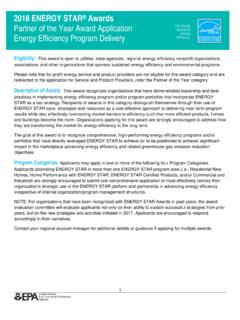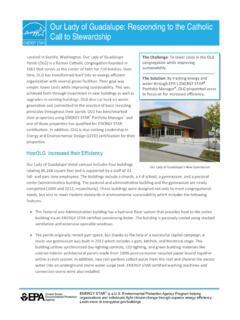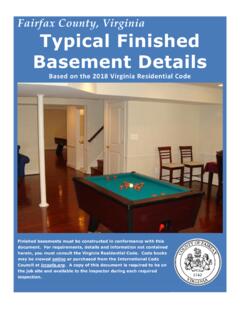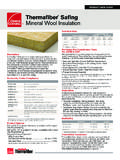Transcription of Insulation Fact Sheet
1 DOE/CE-0180 2008 Department of Energy Assistant Secretary Energy Efficiency and Renewable Energy Contents: Introduction Page 2 Why Insulate Your House? How Insulation Works Which Kind of Insulation is Best? Page 3 What Is an R-Value? Reading the Label Insulation Product Types Insulating a New House Page 8 Where and How Much? Air Sealing Moisture Control and Ventilation Installation Issues o Precautions o Attics o Walls Design Options o Crawlspaces and Slabs o Advanced Wall Framing o Metal Framing o Insulating Concrete Forms o Massive Walls o Structural Insulated Panels o External Insulation Finish System o Attic Ventilation or a Cathedralized Attic Adding Insulation to an Existing House Page 20 Where and How Much How Much Insulation Do I Already Have?
2 Air Sealing Moisture Control and Ventilation Insulation Installation, the Retrofit Challenge o Precautions o Attics o Walls o Basement Walls o Floors and Crawlspaces Resources and Links Page 30 About This Fact Sheet Page 34 Insulation Fact Sheet PDF version 2008 1 Introduction Why Insulate Your House? Heating and cooling account for 50 to 70% of the energy used in the average American home. Inadequate Insulation and air leakage are leading causes of energy waste in most homes.
3 Insulation : saves money and our nation's limited energy resources makes your house more comfortable by helping to maintain a uniform temperature throughout the house, and makes walls, ceilings, and floors warmer in the winter and cooler in the summer. The amount of energy you conserve will depend on several factors: your local climate; the size, shape, and construction of your house; the living habits of your family; the type and efficiency of the heating and cooling systems; and the fuel you use. Once the energy savings have paid for the installation cost, energy conserved is money saved - and saving energy will be even more important as utility rates go up.
4 This fact Sheet will help you to understand how Insulation works, what different types of Insulation are available, and how much Insulation makes sense for your climate. There are many other things you can do to conserve energy in your home as well. The Department of Energy offers many web sites to help you save energy by sealing air leaks, selecting more energy-efficient appliances, etc. How Insulation Works Heat flows naturally from a warmer to a cooler space. In winter, the heat moves directly from all heated living spaces to the outdoors and to adjacent unheated attics, garages, and basements - wherever there is a difference in temperature.
5 During the summer, heat moves from outdoors to the house interior. To maintain comfort, the heat lost in winter must be replaced by your heating system and the heat gained in summer must be removed by your air conditioner. Insulating ceilings, walls, and floors decreases the heating or cooling needed by providing an effective resistance to the flow of heat. Batts, blankets, loose fill, and low- density foams all work by limiting air movement. (These products may be more familiarly called fiberglass, cellulose, polyicynene, and expanded polystyrene.)
6 The still air is an effective insulator because it eliminates convection and has low conduction. Some foams, such as polyisocyanurate, polyurethane, and extruded polystyrene, are filled with special gases that provide additional resistance to heat flow. The ability of Insulation to limit air movement should not be confused with air sealing . The Insulation reduces air movement only within the space it occupies. It will not reduce air movement through other cracks between building parts. For example, controlling air movement within a wall cavity will not stop air that leaks between the foundation and the sill plate or between the wall joists and a window frame.
7 Reflective Insulation works by reducing the amount of energy that travels in the form of radiation. Some forms of reflective Insulation also divide a space up into small regions to reduce air movement, or convection, but not to the same extent as batts, blankets, loose-fill, and foam. Insulation Fact Sheet PDF version 2008 2 Which Kind Of Insulation Is Best? Based on our email, this is one of the most popular questions homeowners ask before buying Insulation . The answer is that the 'best' type of Insulation depends on: how much Insulation is needed, the accessibility of the Insulation location, the space available for the Insulation , local availability and price of Insulation , and other considerations unique to each purchaser.
8 Whenever you compare Insulation products, it is critical that you base your comparison on equal R-values. What Is an R-Value? Insulation is rated in terms of thermal resistance, called R-value, which indicates the resistance to heat flow. The higher the R-value, the greater the insulating effectiveness. The R-value of thermal Insulation depends on the type of material, its thickness, and its density . In calculating the R-value of a multi-layered installation, the R-values of the individual layers are added.
9 The effectiveness of an insulated ceiling, wall or floor depends on how and where the Insulation is installed. Insulation which is compressed will not give you its full rated R-value. This can happen if you add denser Insulation on top of lighter Insulation in an attic. It also happens if you place batts rated for one thickness into a thinner cavity, such as placing R-19 Insulation rated for 6 inches into a 5 inch wall cavity. Insulation placed between joists, rafters, and studs does not retard heat flow through those joists or studs.
10 This heat flow is called thermal bridging. So, the overall R-value of a wall or ceiling will be somewhat different from the R-value of the Insulation itself. That is why it is important that attic Insulation cover the tops of the joists and that is also why we often recommend the use of insulative sheathing on walls. The short-circuiting through metal framing is much greater than that through wood-framed walls; sometimes the insulated metal wall's overall R-value can be as low as half the Insulation 's R-value.
